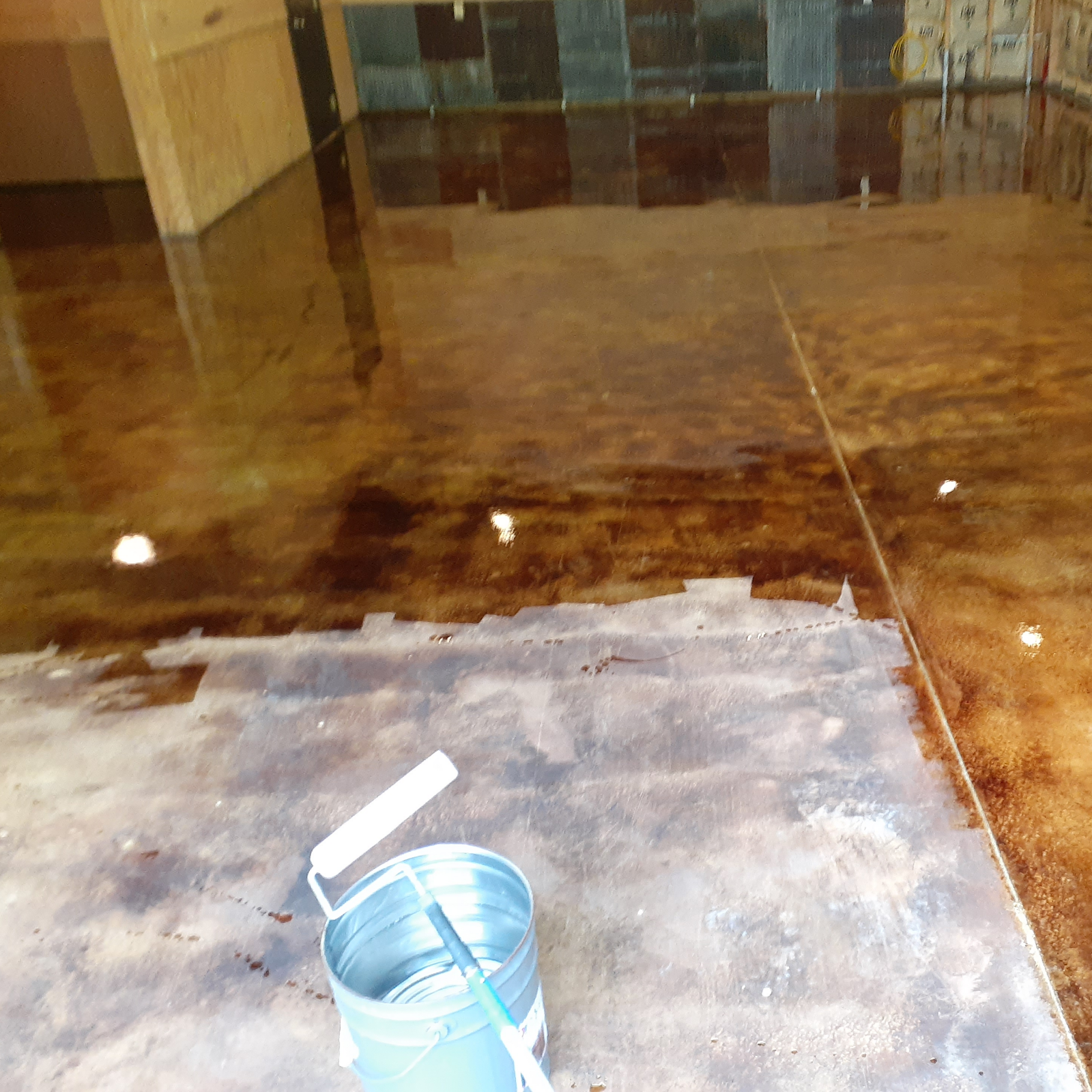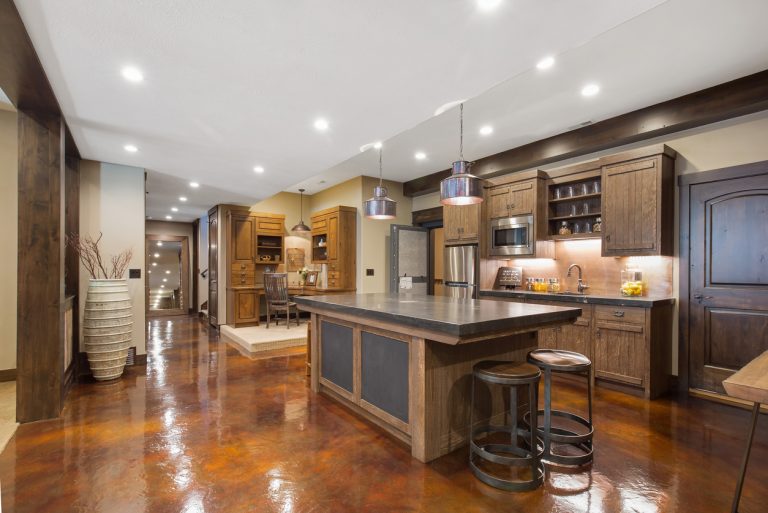Stained concrete austin for outdoor spaces: ideal applications
Everything About Stained Concrete: A Comprehensive Overview to Its Advantages and Applications
Stained concrete has arised as a prominent option for both property and industrial rooms. Its capacity to incorporate aesthetic appeal with functionality makes it a fascinating option. Various discoloration methods offer a series of shades and coatings, enabling modification. Nonetheless, the advantages extend past look. Comprehending its applications and maintenance demands is vital for any individual considering this versatile product. The subtleties of stained concrete welcome even more exploration.
What Is Stained Concrete?

Discoloration can be related to numerous surfaces, including floors, driveways, and patios, making it a functional alternative for both interior and exterior rooms. The therapy can attain a range of appearances, from natural tones to bold, modern styles. Unlike paint, stained concrete keeps its appearance with time, as it comes to be an important part of the concrete itself. Overall, stained concrete works as an efficient method for transforming average concrete into aesthetically striking surface areas.
Benefits of Stained Concrete
Stained concrete offers significant advantages, especially in aesthetic appeal and toughness - Stained Concrete Austin. Its vibrant shades and one-of-a-kind patterns enhance the aesthetic beauty of any type of area, making it a prominent option for both property and business applications. In addition, the longevity of stained concrete assurances that it continues to be a practical investment over time, resisting damage
Visual Appeal
One of the most engaging advantages of utilizing stained concrete is its impressive visual allure. Stained concrete offers a distinct and functional look that can match numerous layout styles, from contemporary to rustic. The mixture of dynamic colors and elaborate patterns permits homeowners and developers to produce tailored surfaces that can improve the general setting of a space. Unlike typical floor covering options, stained concrete can resemble the appearance of all-natural stone or refined marble, providing an upscale appearance without the linked prices. Furthermore, the glossy surface alternatives can mirror light, additional lightening up insides. This adaptability makes stained concrete a favored choice for both property and industrial applications, where aesthetic impact is critical.
Durability and Longevity
The remarkable aesthetic high qualities of stained concrete are matched by its amazing resilience and longevity - Austin Stained Concrete Floors. Stained concrete surface areas are resistant to deterioration, making them suitable for high-traffic locations both inside and outdoors. Their robust nature suggests they can withstand rough climate condition, consisting of severe temperature levels, rainfall, and UV exposure, without significant deterioration. Furthermore, stained concrete needs marginal maintenance contrasted to various other floor covering choices, as it does not require frequent securing or refinishing. This durability not only minimizes replacement expenses however also adds to a lasting structure method. Overall, stained concrete supplies an enduring option that integrates aesthetic allure with useful benefits, guaranteeing its worth over time
Different Kinds Of Staining Methods
Different discoloration strategies can considerably influence the aesthetic qualities of concrete surface areas. The 3 key techniques include acid discoloration, which responds chemically with the concrete, water-based staining, which uses a wider range of shades, and overlay discoloration choices that offer a fresh surface. Each technique has special qualities and applications that satisfy different design choices and task demands.
Acid Discoloration Approach
Just how can homeowners transform simple concrete surface areas into visually striking attributes? One reliable method is acid staining, a preferred technique that enhances the all-natural elegance of concrete. This procedure involves using a solution of water, hydrochloric acid, and metallic salts to the concrete surface area. As the acid reacts with the lime present in the concrete, it develops rich, variegated shades that resemble marble or rock. Acid staining is understood for its durability and resistance to fading, making it a durable selection for both interior and exterior applications. It is vital to keep in mind that the results can differ based on the original concrete color and appearance. Proper application and securing are important for accomplishing the preferred aesthetic and durability
Water-Based Discoloration Technique
A preferred choice to acid staining, the water-based discoloration method uses house owners a flexible means to boost concrete surface areas. This method uses water-soluble dyes and pigments, permitting a large range of shades and coatings. Unlike acid spots, water-based spots can be related to unsealed concrete and use an easier cleaning procedure. The outcomes can attain a more uniform look and can be layered to develop special results. Furthermore, water-based spots are generally less hazardous and give off less unpredictable organic compounds (VOCs), making them a lot more eco-friendly. Home owners may value the ability to customize their concrete surface areas with numerous shades, enabling for imaginative expression while maintaining resilience and durability in their flooring choices.
Overlay Discoloration Options
Numerous overlay staining choices exist for home owners aiming to renew their concrete surface areas. One popular selection is acid discoloration, which responds chemically with the concrete to generate abundant, variegated colors. An additional option is water-based staining, supplying a more comprehensive shade combination and easier application. Furthermore, concrete overlays can be incorporated with stencils for intricate designs, boosting appearances. For a more distinctive coating, homeowners might think about utilizing stamped overlays that resemble all-natural products like stone or ceramic tile. Each strategy gives unique advantages, from sturdiness to modification, permitting a customized touch. Ultimately, the option of overlay staining depends on the preferred look and the condition of the existing concrete, making certain a refreshed and attractive surface.
Applications of Stained Concrete
Stained concrete offers a versatile remedy for numerous applications, boosting both visual appeal and functionality. This product is frequently made use of in residential, industrial, and industrial settings, making it a prominent option among engineers and developers. In homes, stained concrete can function as fashionable flooring more info or outside patios, giving a sophisticated appearance while staying durable.
In industrial spaces, such as retailers and restaurants, stained concrete contributes to a modern-day atmosphere and can withstand hefty foot web traffic. In addition, stained concrete is progressively used in public areas like parks and pathways, where its capability to mimic natural stone or other products adds visual rate of interest.
Stained concrete is optimal for swimming pool decks and driveways, offering a slip-resistant surface that is easy to keep. Overall, the versatility of stained concrete makes it appropriate for various environments, accommodating varied preferences and requirements.
Upkeep and Take Care Of Stained Concrete
Appropriate upkeep ensures the durability and appeal of stained concrete surface areas. Regular cleaning is important; utilizing a moderate cleaning agent and water with a soft-bristle brush helps eliminate dust and gunk without damaging the coating. It is a good idea to avoid severe chemicals that can remove the tarnish or sealer.
Sealing stained concrete is essential for security against dampness, discolorations, and put on. A high-quality sealer ought to be reapplied each to three years, relying on the website traffic and direct exposure the surface area sustains. In addition, resolving spills immediately will prevent staining and discoloration.

Cost Factors To Consider for Stained Concrete Projects
When intending a discolored concrete task, budget plan factors to consider play a crucial role in determining the general price. The expenses connected with stained concrete can differ substantially based on a number of factors. First, the dimension of the location to be stained straight affects material and labor prices. Larger spaces will normally need even more sources. Second, the type of tarnish picked-- acid-based or water-based-- can influence pricing, with acid stains often being a lot more pricey. Furthermore, the intricacy of the style, consisting of patterns or multiple colors, can raise labor expenses. Preparation work, such as cleansing and grinding the concrete surface, contributes to the first expenses as well. The choice between Do it yourself setup and employing a specialist service provider will better affect the budget plan. Recognizing these factors makes it possible for homeowners to make enlightened financial decisions regarding their stained concrete tasks, guaranteeing they achieve the preferred visual within their economic ways.
Tips for Selecting the Right Stained Concrete for Your Space
Selecting the ideal stained concrete for a specific area includes mindful reflection of various variables past just spending plan. Initially, one ought to examine the desired use the area. High-traffic zones may need more resilient surfaces, while ornamental applications can focus on looks.
The color palette is another important element; the picked shades need to balance with existing decoration and illumination. It's also vital to take into account the surface structure, as smooth finishes can boost refinement, while textured choices may assure safety in wet areas.
Regional environment and environmental problems play a considerable duty in the long life and maintenance of stained concrete, affecting the choice of sealants and surfaces.
Finally, seeking advice from experts can give beneficial insights tailored to certain demands, assuring the selection of the suitable stained concrete that straightens with both performance and design.

Often Asked Inquiries
Can Stained Concrete Be Applied Over Existing Flooring?
Stained concrete can undoubtedly be applied over existing floor covering, offered the surface area is secure and effectively prepared. This method enables an aesthetic upgrade without the demand for complete elimination of the original flooring materials.
How Much Time Does Stained Concrete Last?
Stained concrete can last for years when effectively maintained. Factors such as web traffic, ecological problems, and application techniques substantially influence its longevity, with several installations staying vivid and intact for 10 to three decades.
Is Stained Concrete Slippery When Wet?
Stained concrete can be unsafe when damp, as the finish may develop a smooth surface. Using non-slip additives or distinctive surfaces can minimize this issue, boosting safety without jeopardizing the aesthetic charm of the concrete.
Can I Discolor Concrete Myself, or Should I Hire an Expert?
The choice to tarnish concrete directly or employ a specialist depend upon skill level and job complexity. While DIY discoloration can save money, experts guarantee optimal outcomes, specifically for detailed layouts or big surfaces.
What Colors Are Readily Available for Stained Concrete?
The selection of shades offered for stained concrete consists of natural tones like browns and tans, vibrant shades such as reds and blues, and softer shades like pastels. This palette enables innovative, tailored style choices.